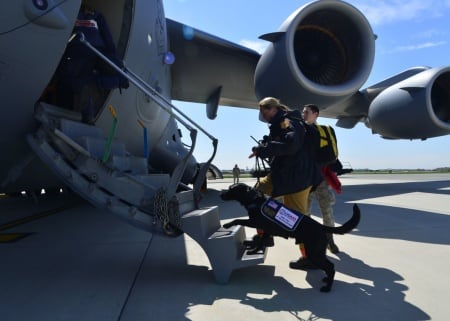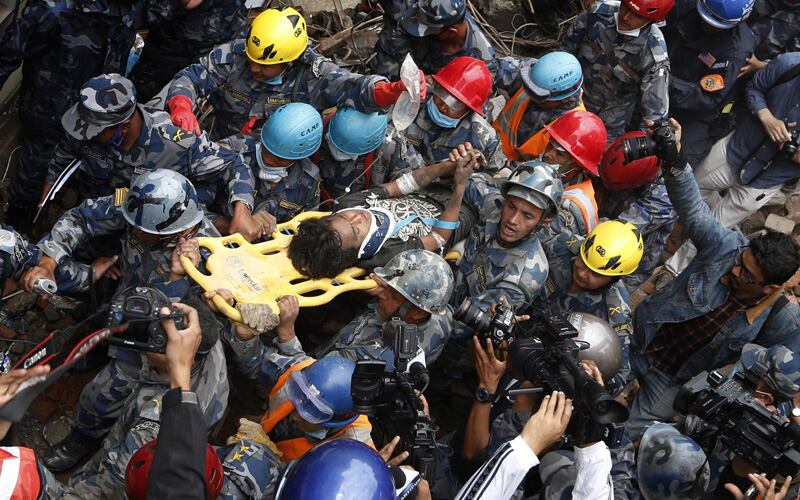Capt. Matthew Hall flew his C-17 from Qatar to Kathmandu delivering a search-and-rescue team from Fairfax County, Virginia, as part of the Nepal earthquake relief effort.
Landing in such rugged terrain was challenging, he said.
"If you can picture in your mind a bowl — just a regular old bowl you'd go eat out of — and picture that all the sides of that bowl are terrain, just high mountains, that is what Kathmandu is like," Hall told Air Force Times in a May 7 interview. "It just an airfield at the base of a valley surrounded on all sides by high mountains. We were at 27,000 feet with mountains poking up above the cloud line."
However, C-17 crews have had ample experience landing in mountainous Afghanistan, Hall said. Bagram Airfield, for example, is about 4,900 feet above sea level, just a little higher than Katmandu.
Kathmandu is the only international airport for Nepal, so with all of the aircraft trying to converge there, Hall's C-17 had to wait for an hour to land with at least five other aircraft below waiting for their turns to land, he said.
As Hall Hall, of the 816th Expeditionary Airlift Squadron, came in for a landing, he had to fly around the clouds because Kathmandu has been deemed unreliable for an instrument landing, Hall he said. The electronic signal emitted from the airport to guide landing airplanes can be lost due to power failures on the ground.
"That's definitely an ugly place to be if you're in weather, in the middle of all that terrain and you lose all of your guidance," Hall said.
After Hall's C-17 landed, the aircrew had to waited for about half an hour to find a parking spot because the runway was so crowded, he said. The situation on the ground was as hectic as a "flea market … on a four-day holiday weekend."
"There was just vehicles going everywhere, people everywhere, just stuff everywhere — all flowing at a fairly safe manner, but just not what you'd picture at a major international airport," Hall said.

Jennifer Massey, Fairfax County Urban Search and Rescue K-9 search specialist, Fairfax, Va., and her K-9, Phayu, board a C-17 Globemaster III April 26 at Dover Air Force Base, Del. Massey and Phayu were part of a 69-person search and rescue team deploying to Nepal to assist in rescue operations after the country was struck by a 7.8-magnitude earthquake.
Photo Credit: Airman 1st Class William Johnson/Air Force
Teamwork was essential as the loadmasters made sure the C-17 didn't hit any of the people and vehicles as the plane backed up, he said.
"I cannot say enough about how well the loadmasters did," Hall said. "Those are the folks that deal with unloading the cargo and making sure it gets off the aircraft safely."
There was only one, small forklift on the runway and it could carry a maximum of 5,000 pounds, he said. The problem was each of the pallets the C-17 was carrying weighed about 8,000 pounds.
"The loadmasters ended up breaking down the pallets, if you can imagine baggage pallets of sorts, and other search-and-rescue equipment," Hall said. "They were tearing them apart by hand in order to get them light enough for the forklift to be able to move off and then downloading all the rest by hand with the help of the search and rescue team."

Nepalese police personnell carry earthquake survivor Pemba Tamang, 15, on a stretcher after his rescue from a destroyed hotel building on April 30 in Kathmandu.
Photo Credit: Getty
The runway at Kathmandu had five parking spots for planes as big as the C-17, he said. The others were taken by aircraft from China, India, Israel, and Thailand. Still, when a U.S. C-17 arrived, everyone on the ground stopped what they were doing to look at it.
"Anybody who had a cell phone had that camera out," Hall said. "That aircraft with that flag garnered a lot of attention on that side of the world."
Hall is nearing the end of his fourth deployment. The flight to Nepal marked his first humanitarian mission, which he found to be much different than flying cargo because he could instantly see the results of his efforts.
"Within 24 hours, I can pull up the news and I can see that the Fairfax County folks saved a 15-year-old boy, and pulled him from the rubble after being there for several days," he said. "By the sheer fact that we got the mission there, got the folks delivered, immediately you can see a return on your investment."





